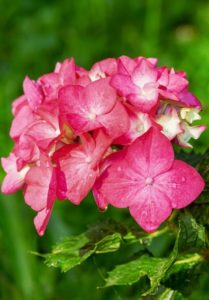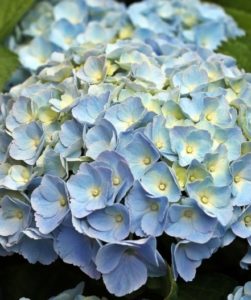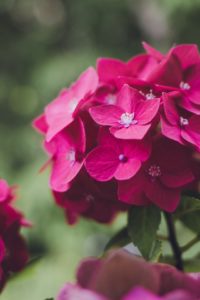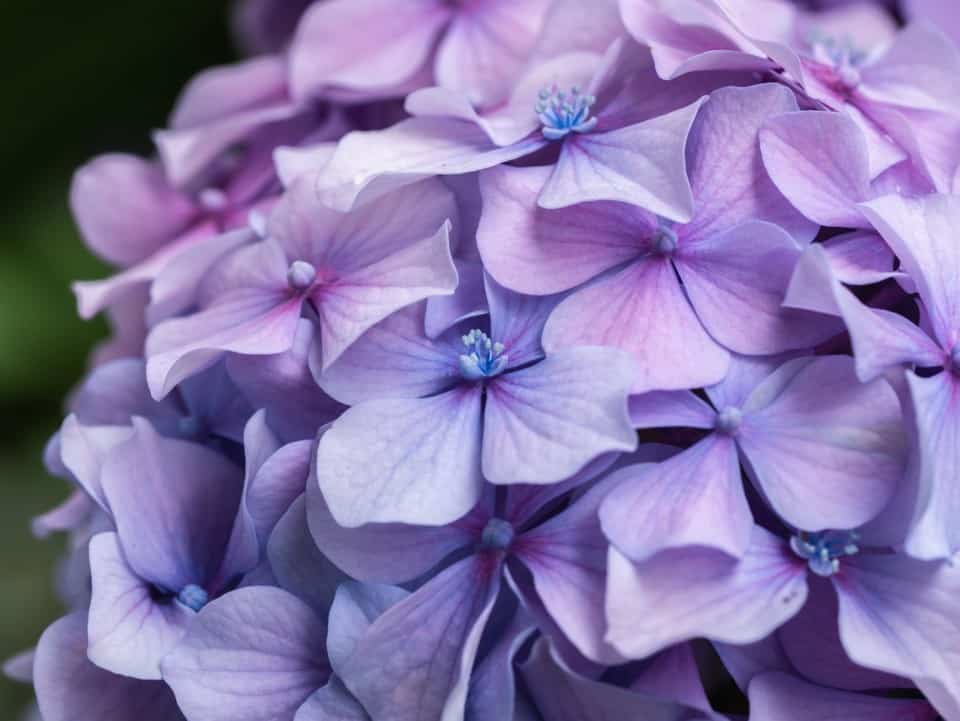Some links in the post are affiliate links and I get a commission from purchases made through some links found in the post.
Landscaping with trees gives the outdoors such an amazing facelift that it’s become the norm. And with this increased popularity, hydrangeas have been at the forefront.
Even so, there’s a bit of confusion as to whether the hydrangea tree exists. Is there such a thing? You may have even come across nurseries that advertise hydrangea trees.
And this might have you wondering what the difference between a hydrangea tree vs a bush is. We will cover that and more in this guide.
Which Hydrangeas are Trees?
Before we get into which hydrangeas are trees and which ones you can classify as bushes, let’s cover the main hydrangea species. Which are they?
1) The Bigleaf Hydrangeas
These species also go by other names like Hortensia and French hydrangeas. They are the most common of the hydrangea species in the US and encompass:
The Mophead Hydrangeas
These feature large flower heads with pink, purple, or blue hues.
Moreover, their leaves are quite glossy and thick (about 5 inches long and 4 inches wide) and often take on the shape of a heart. To the edges, they have coarse teeth. In optimal conditions, these hydrangeas can grow quite large leaves.
The Lacecap Hydrangeas
The mophead hydrangeas and the lacecap hydrangeas have similar leaf shapes. As such, you can mistake one for the other.
However, their blooms are quite different. These feature the fertile flowers at the center, while the outer edges feature the sterile flowers.
The Mountain Hydrangeas
It’s not easy to come across these hydrangeas as they are somewhat rare. They are, however, much hardier than the species above and can survive harsh winters, hence the name. Their blooms are quite small.
2) Panicle Hydrangeas
 Of all the hydrangea species, these are best suited to survive harsh climates. As such, they do quite well in hardiness zones 3 to 7.
Of all the hydrangea species, these are best suited to survive harsh climates. As such, they do quite well in hardiness zones 3 to 7.
Their blooms start as white, and as they mature, they can change to pink. How can you tell these species apart from the others?
You focus on the leaves, which are much smaller and thinner than the mophead hydrangea. Moreover, their edges are much rougher.
3) Smooth Hydrangeas
These species grow as shrubs and are also referred to as wild hydrangeas. Unlike the panicle hydrangeas, these do well in hotter climates.
So, you can cultivate them in hardiness zones 4 to 7. They tend to grow upwards and outwards, so they are ideal for hedges.
How can you tell them apart from the rest? They feature thin leaves with heart shapes and have much coarser edges than the mophead.
4) Oakleaf Hydrangeas
Most hydrangeas get their names from their shapes, and the case is not different with this species. It features leaves like those you would find on a red oak.
They can be small with an average width of 4 inches or as wide as 10 inches! These species are amazing for landscaping as their leaves change color in the fall.
(Tidbit – they are the only hydrangeas that can change color!) So, if you’re looking for something out of the norm, this would be it. This species does best in regions with hot summers.
5) Climbing Hydrangeas
Did you know that some hydrangeas have vining tendencies? Well, now you do! These species, native to Asia, climb up structures and can reach up to 80 feet!
Thus, if you want a landscape that showcases climbing beauties, this would be a good idea. You can grow them in hardiness zones 4 to 8.
If you are enjoying this article, check out our article on hydrangeas vs lilacs.
Now, let’s Get Back to our Question: Which of These Hydrangeas is a Tree?
If we are to be scientific about it, none of these species of hydrangea is an actual tree. They are all bushes. However, the Panicle hydrangeas have some characteristics that make them somewhat trees.
Which are these? For one, it does not form new branches from the root, unlike what bushy species do. Secondly, they feature a central stem that can develop into a trunk, creating the illusion of a tree!
If you go for the Paniculata Grandiflora species, you can look forward to a tree that’s 20 feet tall. And when it starts flowering, you can imagine just how beautiful that would be!
Can other hydrangea species give off this illusion? Sure! The options include:
- Limelight Hydrangeas: These are not trees per se. Thus, you cannot expect them to reach several feet in height. Instead, they can grow to a height of 6 feet with greenish-white blooms.
- Little Lime Hydrangeas: If you are looking for a short tree that will adorn your space, this option will do. It features a unique lime green hue and grows to 4 feet.
What about other species, as earlier mentioned? Well, these start branching out at the ground level (like bushes). So, eventually, they will grow into a bush no matter how much you prune them.
Hydrangea Tree Vs Bush – What’s The Difference?
 The difference between the tree and the bush lies in the growth pattern. Bushes start branching out at the ground level, growing outwards.
The difference between the tree and the bush lies in the growth pattern. Bushes start branching out at the ground level, growing outwards.
However, the tree species start with a central stem that branches off over time but not at the ground level.
Thus, you can get rid of the suckers on the trunk with regular pruning to ensure that the trunk does not branch out too much.
However, you must note that the hydrangea is not a tree. As such, it requires help to maintain its shape, lest it grows into a bush.
Hydrangea Tree Vs Bush – What Are The Pros?
Why would one choose a tree over a bush or vice versa? Let’s consider the advantages of each:
The Hydrangea Tree
What makes the tree such a good deal?
Added Space
Bushes take up a lot of space by growing outward and upward. As such, you cannot incorporate more plants into an area with bushes.
After all, it would suffocate under the bush cover. But with trees, you can introduce other plants in the garden. It makes it easier to hack a magazine-worthy landscape!
Aesthetic Appeal and Visibility
Have you ever viewed a flowering tree? It looks great, even from afar. Moreover, it gives off an exotic vibe and is just the way to achieve a towering beauty.
Besides, with other plants growing underneath the tree, the blossoming flowers will be the icing on the cake.
The Hydrangea Bush
Is a bushy species the best choice for you? It boasts:
Variety
One of the most important pros of the bush varieties is that you get more options. So, you can have fun choosing the species that best matches your landscape or home interior.
Tons of Rare Options
You don’t need to stick to the same old options when cultivating a hydrangea bush. You can try rarer options like the Bristol Hydrangeas and the Miss Saori.
You get to experiment with awe-inspiring species, bringing out the best in your outdoors or home interior.
Both options have a lot to offer.
You may be interested in our article on the common problems with hydrangeas in pots.
Hydrangea Tree Vs Bush – What Are The Cons?
Is there any reason you should ditch the tree for the bush or the bush for the tree? Let’s find out:
The Hydrangea Tree
While having a towering hydrangea tree is a dream come true for many people, it does have some disadvantages:
Limited Variety
We earlier mentioned that the hydrangea typically grows as a bush. As such, the few options that grow as trees are quite limiting.
If you are looking for countless options to find what best suits your hardiness zone and aesthetics, you might fall short.
No Rare Varieties
How great would it be to cultivate an unusual hydrangea variety in your space? Unfortunately, you do not get that opportunity with tree hydrangeas. Again, the selection is quite small.
High Pruning Needs
As much as the tree grows upwards, you must prune it quite often to maintain its shape.
And that means that at least once a year, you must use shears on the tree, adding to its maintenance needs. If you do not follow through on this, the tree will try to turn into a bush!
Cost
Did you know that creating a tree takes a lot of effort? That’s why nurseries often provide trees at much higher costs than bushes.
The Hydrangea Bush
What would make the bush a bad idea for your home or landscape?
Space Limitations
Once a hydrangea bush establishes in the garden, you cannot add more plants to the section. The bush will keep spreading outward, and any new plant in the garden will die because of reduced nourishment.
Reduced Visibility
Bushes tend to skew people’s vision. It might have a beautiful show of flowers, but your eyes might not immediately note the blossoms. It owes to the congestion created by the bushes. So, to view the flowers, one must be close to the landscape.
Prone to Fungal Disease
Bushes grow close to the ground, creating a humid environment where fungi can thrive. Thus, it’s much easier for such species to suffer from diseases that can affect their aesthetics.
Again, both options have significant downsides.
Final Thoughts: Hydrangea Tree vs Bush
 So, which one should you choose? It all depends on why you want the hydrangea in the first place.
So, which one should you choose? It all depends on why you want the hydrangea in the first place.
If you want a unique addition to your landscape that does not take up much space, the tree will work.
But if you want an option that you would not find in most gardens, you can look up rare bush species. What’s it going to be?
Happy Gardening!
Before you go, here are some more related articles I encourage you to read below to help solve more of your gardening issues:
How to use baking soda to grow hydrangeas


